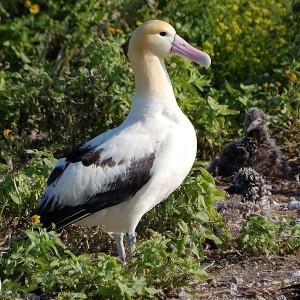Sea Level Rise Drove Out Albatross
 Researchers who unearthed the first fossilised breeding colony of albatrosses in Bermuda in 2003 concluded a massive jump in sea level — to more than 65 feet above its current height — drove the birds out 400,000 years ago.
Researchers who unearthed the first fossilised breeding colony of albatrosses in Bermuda in 2003 concluded a massive jump in sea level — to more than 65 feet above its current height — drove the birds out 400,000 years ago.
No albatrosses live in Bermuda today or anywhere else in the North Atlantic.
After the Bermuda colony was discovered at the Government Quarry, Storrs Olson of the National Museum of Natural History in Washington DC told the British magazine: ”Nature” that albatrosses would probably still be there if we hadn’t had the rise.”
Future rises, perhaps due to global warming, could take a similarly heavy toll on birds and other shore dwellers warned Mr. Olson.
All of the Bermuda birds were short-tailed albatrosses [pictured at top]. This critically endangered species is now found on only a few islands off Japan, having been all but wiped out by feather-collectors a century ago.
Elsewhere, albatrosses are under threat from accidental killings by long-line fishing.
The birds breed on islands, on open land by the sea. Their taste for wind-swept nesting sites makes them unlikely fossils. The Bermuda colony was entombed under several metres of sand in a single storm, burying adults, eggs and chicks.
“People have always wondered whether there was a North Atlantic breeding colony, and where they might have been,” ecologist Richard Phillips of the British Antarctic Survey told “Nature”.
The Bermuda colony was swamped at around the time that the West Antarctic Ice Sheet melted, causing a dramatic rise in sea level.
This would have flooded all of the good breeding sites on Bermuda, as well as those on many other islands.
Read More About
Category: All, Environment


The Bermuda Museum of Natural History (at the Aquarium)has a fossil albatross egg on exhibit – as part of its sea-level rise exhibit. It is one of several fossil eggs in the Museum’s collection. Other fossils on exhibit include a crab, sand dollar, turtle eggs, snails, tortoise and sand dune. Come and see them!